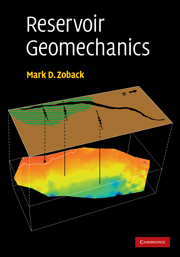Book contents
- Frontmatter
- Contents
- Preface
- PART I BASIC PRINCIPLES
- PART II MEASURING STRESS ORIENTATION AND MAGNITUDE
- 6 Compressive and tensile failures in vertical wells
- 7 Determination of S3 from mini-fracs and extended leak-off tests and constraining the magnitude of SHmax from wellbore failures in vertical wells
- 8 Wellbore failure and stress determination in deviated wells
- 9 Stress fields – from tectonic plates to reservoirs around the world
- PART III APPLICATIONS
- References
- Index
- Plate section
8 - Wellbore failure and stress determination in deviated wells
Published online by Cambridge University Press: 10 December 2009
- Frontmatter
- Contents
- Preface
- PART I BASIC PRINCIPLES
- PART II MEASURING STRESS ORIENTATION AND MAGNITUDE
- 6 Compressive and tensile failures in vertical wells
- 7 Determination of S3 from mini-fracs and extended leak-off tests and constraining the magnitude of SHmax from wellbore failures in vertical wells
- 8 Wellbore failure and stress determination in deviated wells
- 9 Stress fields – from tectonic plates to reservoirs around the world
- PART III APPLICATIONS
- References
- Index
- Plate section
Summary
Many wells being drilled for oil and gas production are either horizontal, highly deviated from vertical or have complex trajectories. Because of this, it is necessary to understand the factors that control the occurrence of compressive and tensile failures in wells with arbitrary orientation. In this section, I generalize the material presented in Chapters 6 and 7 for wells of any orientation. I begin the chapter by considering the ways in which compressive failures (breakouts) and drilling-induced tensile fractures occur in arbitrarily oriented wells in normal, strike-slip and reverse faulting environments. The basic principles of failure of wells with arbitrary orientation will be utilized extensively when applied to wellbore stability in Chapter 10.
Most analyses of breakouts and tensile fracture compilations do not include observations of failures in inclined boreholes. There are three reasons for this. First, four-arm caliper logs (typically used to study breakouts) frequently track key seats as discussed in Chapter 6. This makes it difficult to detect breakouts with caliper data. Second, breakout directions in deviated holes vary significantly from what would occur in vertical holes (e.g. Mastin 1988; Peska and Zoback 1995). The same is true of drilling-induced tensile fractures. Thus, it is not straightforward to relate breakout and tensile fracture observations to stress directions. Third, drilling-induced tensile fractures in deviated wells occur in an en echelon pattern at an angle to the wellbore axis and can be difficult to distinguish from natural fractures in the formation.
- Type
- Chapter
- Information
- Reservoir Geomechanics , pp. 235 - 265Publisher: Cambridge University PressPrint publication year: 2007

